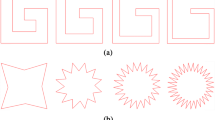Abstract
The geometric element transformation method (GETMe) is a geometry-based smoothing method for mixed and non-mixed meshes. It is based on a simple geometric transformation applicable to elements bounded by polygons with an arbitrary number of nodes. The transformation, if applied iteratively, leads to a regularization of the polygons. Global mesh smoothing is accomplished by averaging the new node positions obtained by local element transformations. Thereby, the choice of transformation parameters as well as averaging weights can be based on the element quality which leads to high quality results. In this paper, a concept of an enhanced transformation approach is presented and a proof for the regularizing effect of the transformation based on eigenpolygons is given. Numerical examples confirm that the GETMe approach leads to superior mesh quality if compared to other geometry-based methods. In terms of quality it can even compete with optimization-based techniques, despite being conceptually significantly simpler.











Similar content being viewed by others
References
Amenta N, Bern M, Eppstein D (1997) Optimal point placement for mesh smoothing. In: Proceedings of the 8th annual ACM-SIAM Symposium on Discrete Algorithms, pp 528–537
Balendran B (1999) A direct smoothing method for surface meshes. In: Proceedings of the 8th international meshing roundtable. Sandia National Laboratories, pp 303–308
Brewer M, Freitag Diachin L, Knupp P, Leurent T, Melander D (2003) The Mesquite mesh quality improvement toolkit. In: Proceedings of the 12th international meshing roundtable. Sandia National Laboratories, pp 239–250
Canann SA, Tristano JR, Staten ML (1998) An approach to combined Laplacian and optimization-based smoothing for triangular, quadrilateral, and quad-dominant meshes. In: Proceedings of the 7th international meshing roundtable. Sandia National Laboratories, pp 479–494
Chen Z, Tristano JR, Kwok W (2003) Combined Laplacian and optimization-based smoothing for quadratic mixed surface meshes. In: Proceedings of the 12th international meshing roundtable. Sandia National Laboratories, pp 361–370
Courty F, Leservoisier D, George PL, Dervieux A (2006) Continuous metrics and mesh adaptation. Appl Numer Math 56(2):117–145
Davis PJ (1994) Circulant matrices, 2nd edn. Chelsea Publishing, New York
Diachin L, Knupp P, Munson T, Shontz S (2004) A comparison of inexact Newton and coordinate descent mesh optimization techniques. In: Proceedings of the 13th international meshing roundtable. Sandia National Laboratories, pp 243–254
Egorova O, Kojekine N, Hagiwara I, Savchenko M, Semenova I, Savchenko V (2003) Improvement of mesh quality using a statistical approach. In: Proceedings of the 3rd IASTED international conference on visualization, imaging and image processing, vol 2, pp 1016–1021
Escobar JM, Montero G, Montenegro R, Rodríguez E (2006) An algebraic method for smoothing surface triangulations on a local parametric space. Int J Numer Methods Eng 66(4):740–760
Field DA (1988) Laplacian smoothing and Delaunay triangulations. Commun Appl Numer Methods 4(6):709–712
Freitag LA (1997) On combining Laplacian and optimization-based mesh smoothing techniques. AMD trends in unstructured mesh generation. ASME 220:37–43
Freitag LA, Jones MT, Plassmann PE (1999) A parallel algorithm for mesh smoothing. SIAM J Sci Comput 20(6):2023–2040
Frey PJ, George PL (2008) Mesh generation: application to finite elements. ISTE Publishing Company
Garimella RV, Shashkov MJ, Knupp PM (2004) Triangular and quadrilateral surface mesh quality optimization using local parameterization. Comput Methods Appl Mech Eng 193(9–11):913–928
Knupp PM (2001) Algebraic mesh quality metrics. SIAM J Sci Comput 23(1):193–218
Knupp PM (2007) Remarks on mesh quality. In: Proceedings of the 45th AIAA aerospace sciences meeting and exhibit
Lo SH (1985) A new mesh generation scheme for arbitrary planar domains. Int J Numer Methods Eng 21(8):1403–1426
Lohner R, Morgan K, Zienkiewicz OC (1986) Adaptive grid refinement for compressible Euler equations. In: Babuska I et al (eds) Accuracy estimates and adaptive refinements in finite element computations. Wiley, pp 281–297
Mesh Quality Improvement Toolkit (Mesquite), Version 1.1. http://www.cs.sandia.gov/optimization/knupp/Mesquite.html. Accessed 15 Feb 2008
Munson T (2007) Mesh shape-quality optimization using the inverse mean-ratio metric. Math Program Ser A/B 110(3):561–590
Owen SJ, Shephard MS (eds) (2003) Special issue: trends in unstructured mesh generation. Int J Numer Methods Eng 58(2)
Rypl D (2003) Approaches to discretization of 3D surfaces. Habilitation thesis, CTU Reports 7-2
Shimada K, Gossard DC (1995) Bubble mesh: automated triangular meshing of non-manifold geometry by sphere packing. In: Proceedings of the 3rd ACM symposium on solid modeling and applications, pp 409–419
Thompson JF, Soni BK, Weatherill NP (eds) (1998) Handbook of grid generation. CRC Press
Vartziotis D (2007) The polygon: a problem (No. 11328). The American Mathematical Monthly (accepted)
Vartziotis D, Athanasiadis T, Goudas I, Wipper J (2008) Mesh smoothing using the geometric element transformation method. Comput Methods Appl Mech Eng 197(45–48):3760–3767
Zhihong M, Lizhuang M, Mingxi Z, Zhong L (2006) A modified Laplacian smoothing approach with mesh saliency. Lecture Notes in Computer Science, vol 4073, pp 105–113
Zhou T, Shimada K (2000) An angle-based approach to two-dimensional mesh smoothing. In: Proceedings of the 9th international meshing roundtable. Sandia National Laboratories, pp 373–384
Author information
Authors and Affiliations
Corresponding author
Rights and permissions
About this article
Cite this article
Vartziotis, D., Wipper, J. The geometric element transformation method for mixed mesh smoothing. Engineering with Computers 25, 287–301 (2009). https://doi.org/10.1007/s00366-009-0125-6
Received:
Accepted:
Published:
Issue Date:
DOI: https://doi.org/10.1007/s00366-009-0125-6




